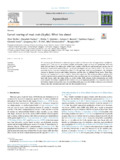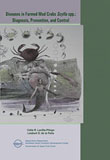Morphological deformities in mud crab Scylla serrata juveniles exposed to antibiotics during the larval stage
- Global styles
- MLA
- Vancouver
- Elsevier - Harvard
- APA
- Help
Share
抄録
The effects of antibiotics on the survival, growth and external deformities of mud crab Scylla serrata larvae and juveniles were determined. Zoeae were exposed to 0, 3, 6, 9, 12 mgL-1 oxytetracycline (OTC) and 0, 0.5, 1, 1.5, 2 mgL-1 furazolidone (furan) until the late megalopa in the first and second experiments. The treatments that gave the best results in the first and second experiments were conducted simultaneously in the third experiment. The surviving crab instar from each replicate were grown in nursery tanks for one month.
Significantly higher survival and faster growth rate of Z5 were attained when 3 and 6 mgL-1 OTC or 0.5 and 1 mgL-1 furan were used. Morphological deformities observed in zoea 5 were bent dorsal, rostral and furcal spines. Percentage occurrence of morphological deformities was similar in all treatments. Significantly (P<0.05) higher survival and faster growth were attained among Z5 in the treatments using 3 mgL-1 OTC and 0.5 mL-1 furan in the third experiment. Morphological deformities observed in juveniles were fused frontal and lateral spines, asymmetrical and depressed tip of abdominal flap and gap between sternites. High percentage of deformities was observed in juveniles that were previously exposed to 6 mgL-1 OTC or 1.0 mgL-1 furan. There was no significant difference (P>0.05) observed in the survival of juveniles in both treatments of OTC and furan. However, growth was significantly (P<0.05) faster in lower concentrations of the two antibiotics.
The study shows the apparent negative effects of antibiotics and highlights the need to eliminate or find alternatives, thereby preventing possible harm to the organisms and the environment.
記述
Abstract only.
Suggested Citation
Pates Jr., G. S., Quinitio, E. T., Quinitio, G. F., & Parado-Estepa, F. D. (2017). Morphological deformities in mud crab Scylla serrata juveniles exposed to antibiotics during the larval stage. In E. T. Quinitio, F. D. Parado-Estepa, & R. M. Coloso (Eds.), Philippines : In the forefront of the mud crab industry development : proceedings of the 1st National Mud Crab Congress, 16-18 November 2015, Iloilo City, Philippines (p. 146). Tigbauan, Iloilo, Philippines: Aquaculture Department, Southeast Asian Fisheries Development Center.
Type
Conference paperISBN
9789719931072Collections
Related items
Showing items related by title, author, creator and subject.
-
Larval rearing of mud crab (Scylla): What lies ahead
Waiho, Khor; Fazhan, Hanafiah; Quinitio, Emilia T. ; Baylon, Juliana C.; Fujaya, Yushinta; Azmie, Ghazali; Wu, Qingyang; Shi, Xi; Ikhwanuddin, Mhd; Ma, Hongyu (Elsevier, 2018)
The increasing global demand for mud crabs (genus Scylla) and threats to the wild populations highlight the urgency of fully rearing them in captivity. Despite considerable progress in mud crab production, most crab farms ...
; Baylon, Juliana C.; Fujaya, Yushinta; Azmie, Ghazali; Wu, Qingyang; Shi, Xi; Ikhwanuddin, Mhd; Ma, Hongyu (Elsevier, 2018)
The increasing global demand for mud crabs (genus Scylla) and threats to the wild populations highlight the urgency of fully rearing them in captivity. Despite considerable progress in mud crab production, most crab farms ... -
Diseases in farmed mud crabs Scylla spp.: Diagnosis, prevention, and control.
Lavilla-Pitogo, Celia R.; de la Peña, Leobert D. (Aquaculture Dept., Southeast Asian Fisheries Development Center, 2004-12)Aquaculture production has suffered many set-backs due to the occurrence of diseases. Many of the diseases are caused by infectious organisms that are difficult to detect and need sophisticated instruments for diagnosis, ... -
Mud crab pond and pen culture
Rodriguez, Eduard M. (University of the Philippines Aquaculture Society, Inc, 2001)






